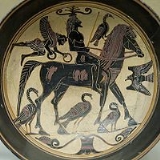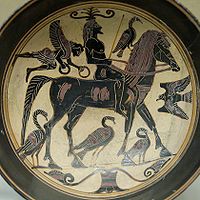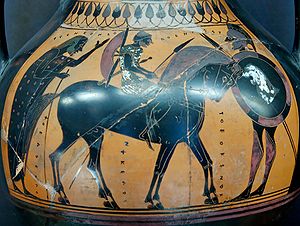
Hippeis
Encyclopedia
Hippeis was the Greek
term for cavalry
. The Hippeus (ἱππεύς) was the second highest of the four Athenian social classes, made of men who could afford to maintain a war horse in the service of the state. The rank may be compared to Roman Equestrians
and medieval knight
s.
 Among the Athenians, it referred to citizens whose property qualified them for the second class. (See Solonian Constitution
Among the Athenians, it referred to citizens whose property qualified them for the second class. (See Solonian Constitution
)
Among the Sparta
ns, it was the royal guard of honour, consisting of 300 chosen Spartan youth under the age of thirty, who, although originally mounted, afterwards served as heavily-armed foot-soldiers. The cavalry of Athens, which was first formed after the Greco-Persian War, and then consisted of 300 men, from the Periclean period onwards consisted of 1,200 men, including 200 mounted bowmen (hippotoxōtœ), who were slaves belonging to the state, and 1,000 citizens of the two highest classes. They were kept together in time of peace, and carefully drilled; at the great public festivals they took part in the processions. They were commanded by two hipparchi, each of whom had five phylai under him and superintended the levy. Subordinate to these were the ten phylarchi in command of ten phylai. Both sets of officers were drawn from the two highest classes. It was the duty of the boule
(council) to see that the cavalry was in good condition, and also to examine new members in respect of their equipment and their eligibility.
The number of horsemen to be dispatched to the field was determined by the decree of the popular assembly. Every citizen-soldier received equipment-money on joining, and during his time of service a subsidy towards keeping a groom and two horses; this grew to be an annual grant from the state, amounting to forty talents
, but regular pay was only given in the field.
 At Sparta it was not until 404 BCE that a regular body of horse was formed, the cavalry being much neglected as compared with the infantry. The rich had only to provide horses, equipment, and armour; for actual cavalry service in time of war, only those unfit for the heavy-armed infantry were drafted off and sent to the field without any preliminary drill. In later times every mora
At Sparta it was not until 404 BCE that a regular body of horse was formed, the cavalry being much neglected as compared with the infantry. The rich had only to provide horses, equipment, and armour; for actual cavalry service in time of war, only those unfit for the heavy-armed infantry were drafted off and sent to the field without any preliminary drill. In later times every mora
of heavy-armed infantry seems to have had allotted to it a mora of cavalry, of uncertain number. By enlisting mercenaries, and introducing allies into their forces, the Spartans at length obtained better cavalry.
The utility of the Greek citizen-cavalry was small on account of their heavy armour, their metal helmet, and their coat of mail, their kilt fringed with metal flaps, their cuisses reaching to the knee, and their leather leggings. They did not take shields into action. As offensive weapons they had the straight two-edged sword and a spear, used either as a lance or a javelin. Shoeing of horses was unknown to the Greeks, as was the use of stirrups. If anything was used as a saddle, it was either a saddle-cloth or a piece of felt, which was firmly fastened with girths under the horse's belly. The Thessalians
were considered the best riders. Trained in horsemanship as well as infantry warfare, the Sacred Band of Thebes
may have been among the volunteer cavalry accompanying the great Theban cavalry commander Pelopidas
, (from whom Philip II of Macedon
learned many cavalry skills, to Pelopidas's fatal confrontation with Alexander of Pherae
in 364. Cavalry first became important in the Macedonian army under Philip II of Macedon
and his son Alexander the Great. Although in earlier times the number of horsemen in the Greek forces was only very small, in the army which Alexander marched into Asia they formed nearly a sixth. The Macedonian cavalry was divided into heavy and light, both consisting of squadrons (ilai) of an average strength of 200 men. Of the heavy cavalry the choicest troops were the Macedonian and Thessalian horsemen, armed in the Greek fashion, who were as formidable in onslaught as in single combat; in order and discipline they far surpassed the dense squadrons of the Asiatic cavalry, and even in attacking the infantry of the enemy they had generally a decisive effect. The light cavalry, which was constituted under the name of prodromoi (skirmishers), consisted of Macedonian sarissophoroi, so called from the sarissa
, a lance from 14 to 16 feet (4.9 m) long (Polybius
, XVIII, 12), and of Thracian
horsemen. The heavy-cavalry men each had a mounted servant and probably a led horse for the transport of baggage and forage. In the time after Alexander there came into existence what were called the Tarentini equites, or light-armed spearmen, with two horses each (192 BCE, Livy
, XXXV 28, 29).
Ancient Greece
Ancient Greece is a civilization belonging to a period of Greek history that lasted from the Archaic period of the 8th to 6th centuries BC to the end of antiquity. Immediately following this period was the beginning of the Early Middle Ages and the Byzantine era. Included in Ancient Greece is the...
term for cavalry
Cavalry
Cavalry or horsemen were soldiers or warriors who fought mounted on horseback. Cavalry were historically the third oldest and the most mobile of the combat arms...
. The Hippeus (ἱππεύς) was the second highest of the four Athenian social classes, made of men who could afford to maintain a war horse in the service of the state. The rank may be compared to Roman Equestrians
Equestrian (Roman)
The Roman equestrian order constituted the lower of the two aristocratic classes of ancient Rome, ranking below the patricians , a hereditary caste that monopolised political power during the regal era and during the early Republic . A member of the equestrian order was known as an eques...
and medieval knight
Knight
A knight was a member of a class of lower nobility in the High Middle Ages.By the Late Middle Ages, the rank had become associated with the ideals of chivalry, a code of conduct for the perfect courtly Christian warrior....
s.

Solonian Constitution
The Solonian Constitution was created by Solon in the early 6th century BC.Solon wanted to revise or abolish the older laws of Draco. Under Solon's reforms, all debts were abolished and all debt-slaves were freed. The status of the hectemoroi , who farmed in an early form of serfdom, was also...
)
Among the Sparta
Sparta
Sparta or Lacedaemon, was a prominent city-state in ancient Greece, situated on the banks of the River Eurotas in Laconia, in south-eastern Peloponnese. It emerged as a political entity around the 10th century BC, when the invading Dorians subjugated the local, non-Dorian population. From c...
ns, it was the royal guard of honour, consisting of 300 chosen Spartan youth under the age of thirty, who, although originally mounted, afterwards served as heavily-armed foot-soldiers. The cavalry of Athens, which was first formed after the Greco-Persian War, and then consisted of 300 men, from the Periclean period onwards consisted of 1,200 men, including 200 mounted bowmen (hippotoxōtœ), who were slaves belonging to the state, and 1,000 citizens of the two highest classes. They were kept together in time of peace, and carefully drilled; at the great public festivals they took part in the processions. They were commanded by two hipparchi, each of whom had five phylai under him and superintended the levy. Subordinate to these were the ten phylarchi in command of ten phylai. Both sets of officers were drawn from the two highest classes. It was the duty of the boule
Boule (Ancient Greece)
In cities of ancient Greece, the boule meaning to will ) was a council of citizens appointed to run daily affairs of the city...
(council) to see that the cavalry was in good condition, and also to examine new members in respect of their equipment and their eligibility.
The number of horsemen to be dispatched to the field was determined by the decree of the popular assembly. Every citizen-soldier received equipment-money on joining, and during his time of service a subsidy towards keeping a groom and two horses; this grew to be an annual grant from the state, amounting to forty talents
Talent (weight)
The "talent" was one of several ancient units of mass, as well as corresponding units of value equivalent to these masses of a precious metal. It was approximately the mass of water required to fill an amphora. A Greek, or Attic talent, was , a Roman talent was , an Egyptian talent was , and a...
, but regular pay was only given in the field.

Mora (military unit)
A mora was an ancient Spartan military unit of about a sixth of the Spartan army, at approx. 600 men by modern estimates, although Xenophon places it at 6000. This can be reconciled by the nature of the Spartan army with an organisation based on year classes, with only the younger troops being...
of heavy-armed infantry seems to have had allotted to it a mora of cavalry, of uncertain number. By enlisting mercenaries, and introducing allies into their forces, the Spartans at length obtained better cavalry.
The utility of the Greek citizen-cavalry was small on account of their heavy armour, their metal helmet, and their coat of mail, their kilt fringed with metal flaps, their cuisses reaching to the knee, and their leather leggings. They did not take shields into action. As offensive weapons they had the straight two-edged sword and a spear, used either as a lance or a javelin. Shoeing of horses was unknown to the Greeks, as was the use of stirrups. If anything was used as a saddle, it was either a saddle-cloth or a piece of felt, which was firmly fastened with girths under the horse's belly. The Thessalians
Thessaly
Thessaly is a traditional geographical region and an administrative region of Greece, comprising most of the ancient region of the same name. Before the Greek Dark Ages, Thessaly was known as Aeolia, and appears thus in Homer's Odyssey....
were considered the best riders. Trained in horsemanship as well as infantry warfare, the Sacred Band of Thebes
Sacred Band of Thebes
The Sacred Band of Thebes was a troop of picked soldiers, consisting of 150 male couples which formed the elite force of the Theban army in the 4th century BC. It was organised by the Theban commander Gorgidas in 378 BC and played a crucial role in the Battle of Leuctra...
may have been among the volunteer cavalry accompanying the great Theban cavalry commander Pelopidas
Pelopidas
Pelopidas was an important Theban statesman and general in Greece.-Athlete and warrior:He was a member of a distinguished family, and possessed great wealth which he expended on his friends, while content to lead the life of an athlete...
, (from whom Philip II of Macedon
Philip II of Macedon
Philip II of Macedon "friend" + ἵππος "horse" — transliterated ; 382 – 336 BC), was a king of Macedon from 359 BC until his assassination in 336 BC. He was the father of Alexander the Great and Philip III.-Biography:...
learned many cavalry skills, to Pelopidas's fatal confrontation with Alexander of Pherae
Alexander of Pherae
Alexander was tagus or despot of Pherae in Thessaly, and ruled from 369 BC to 358 BC.-Reign:The accounts of how he came to power vary somewhat in minor points. Diodorus Siculus tells us that upon the assassination of the tyrant Jason of Pherae, in 370 BC, his brother Polydorus ruled for a year,...
in 364. Cavalry first became important in the Macedonian army under Philip II of Macedon
Philip II of Macedon
Philip II of Macedon "friend" + ἵππος "horse" — transliterated ; 382 – 336 BC), was a king of Macedon from 359 BC until his assassination in 336 BC. He was the father of Alexander the Great and Philip III.-Biography:...
and his son Alexander the Great. Although in earlier times the number of horsemen in the Greek forces was only very small, in the army which Alexander marched into Asia they formed nearly a sixth. The Macedonian cavalry was divided into heavy and light, both consisting of squadrons (ilai) of an average strength of 200 men. Of the heavy cavalry the choicest troops were the Macedonian and Thessalian horsemen, armed in the Greek fashion, who were as formidable in onslaught as in single combat; in order and discipline they far surpassed the dense squadrons of the Asiatic cavalry, and even in attacking the infantry of the enemy they had generally a decisive effect. The light cavalry, which was constituted under the name of prodromoi (skirmishers), consisted of Macedonian sarissophoroi, so called from the sarissa
Sarissa
The sarissa or sarisa was a 4 to 7 meter long spear used in the ancient Greek and Hellenistic warfare. It was introduced by Philip II of Macedon and was used in the traditional Greek phalanx formation as a replacement for the earlier dory, which was considerably shorter. The phalanxes of Philip...
, a lance from 14 to 16 feet (4.9 m) long (Polybius
Polybius
Polybius , Greek ) was a Greek historian of the Hellenistic Period noted for his work, The Histories, which covered the period of 220–146 BC in detail. The work describes in part the rise of the Roman Republic and its gradual domination over Greece...
, XVIII, 12), and of Thracian
Thrace
Thrace is a historical and geographic area in southeast Europe. As a geographical concept, Thrace designates a region bounded by the Balkan Mountains on the north, Rhodope Mountains and the Aegean Sea on the south, and by the Black Sea and the Sea of Marmara on the east...
horsemen. The heavy-cavalry men each had a mounted servant and probably a led horse for the transport of baggage and forage. In the time after Alexander there came into existence what were called the Tarentini equites, or light-armed spearmen, with two horses each (192 BCE, Livy
Livy
Titus Livius — known as Livy in English — was a Roman historian who wrote a monumental history of Rome and the Roman people. Ab Urbe Condita Libri, "Chapters from the Foundation of the City," covering the period from the earliest legends of Rome well before the traditional foundation in 753 BC...
, XXXV 28, 29).
See also
- Corpus vasorum antiquorumCorpus vasorum antiquorumCorpus Vasorum Antiquorum is an international research project for ceramic documentation of the classical area.CVA is the first and oldest research project of the Union Académique Internationale of France. The first project meeting was organized by Edmond Pottier in Paris in 1919. The final...
- The KnightsThe KnightsThe Knights was the fourth play written by Aristophanes, the master of an ancient form of drama known as Old Comedy. The play is a satire on the social and political life of classical Athens during the Peloponnesian War and in this respect it is typical of all the dramatist's early plays...
- The Sacred Band of StepsonsThe Sacred Band of StepsonsThe Sacred Band of Stepsons is a fictional ancient cavalry unit created by Janet Morris and based on the historical Sacred Band of Thebes, an elite strike force of paired lovers and friends that flourished during the fourth century BCE in ancient Greece, where sexuality was a behavior, not an...
, fictional ancient cavalry

